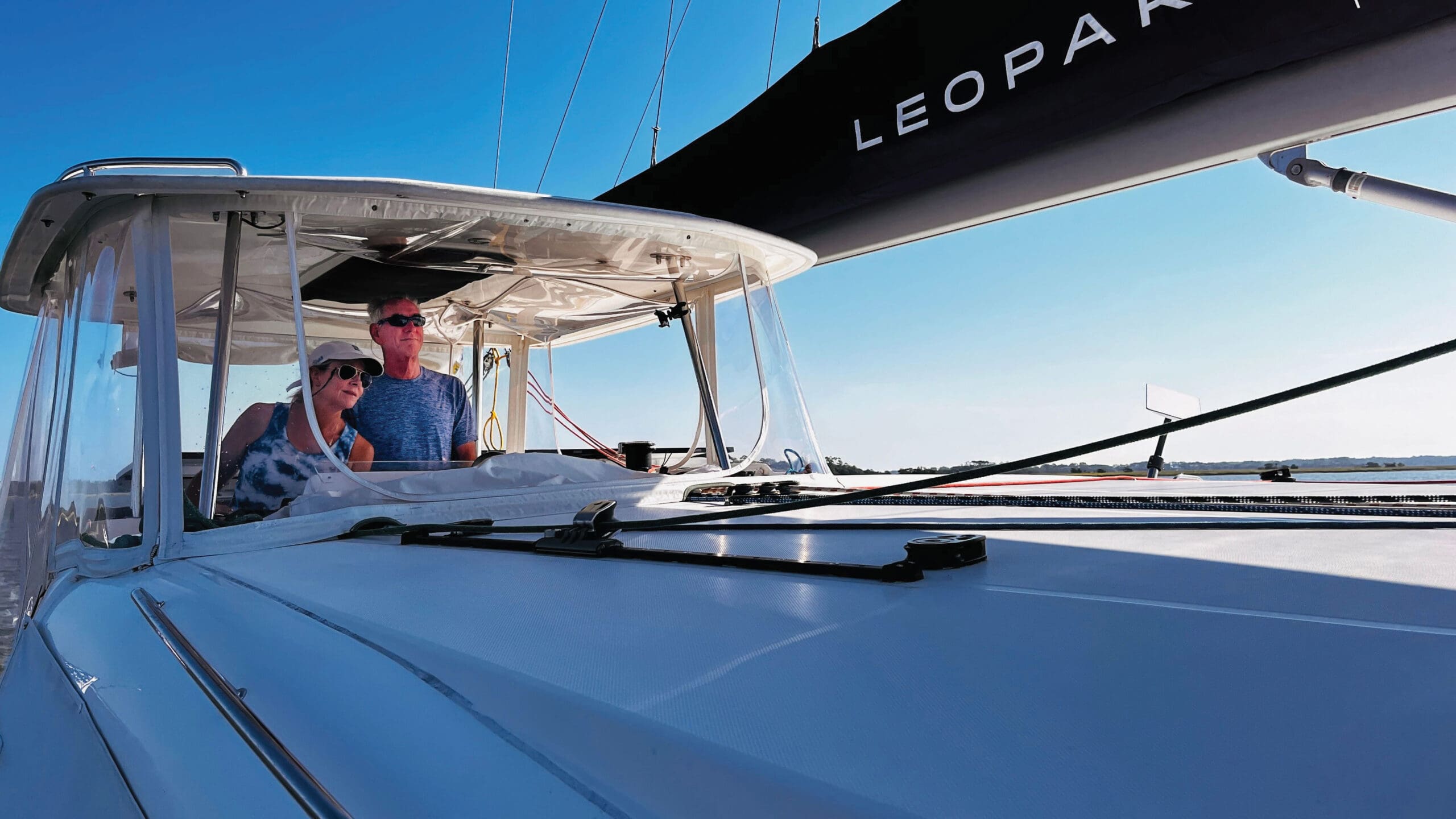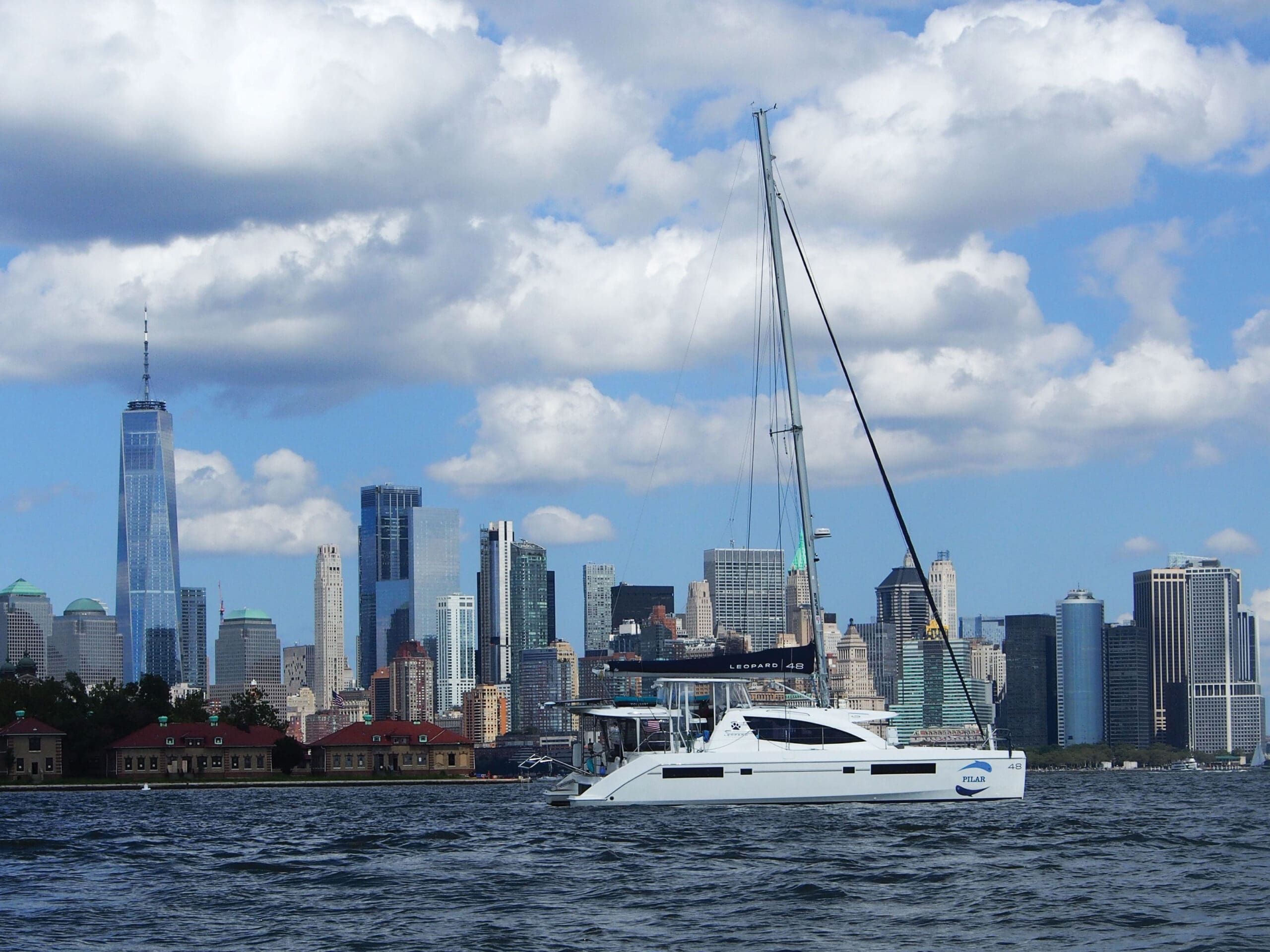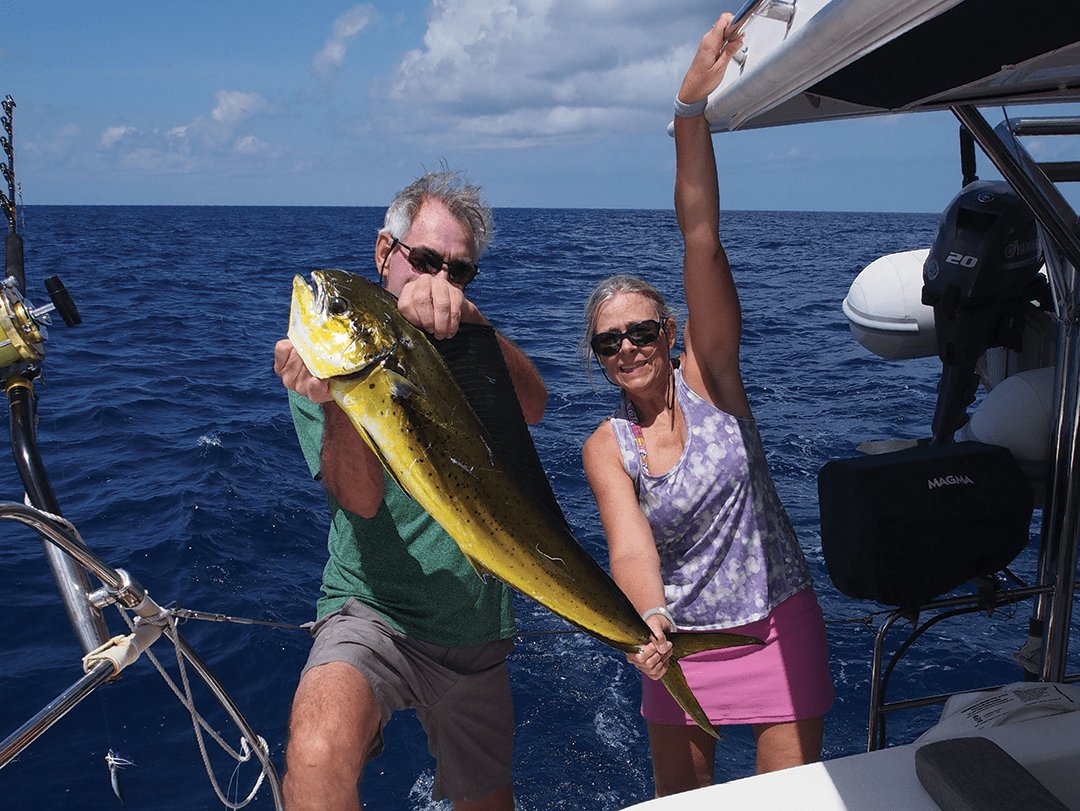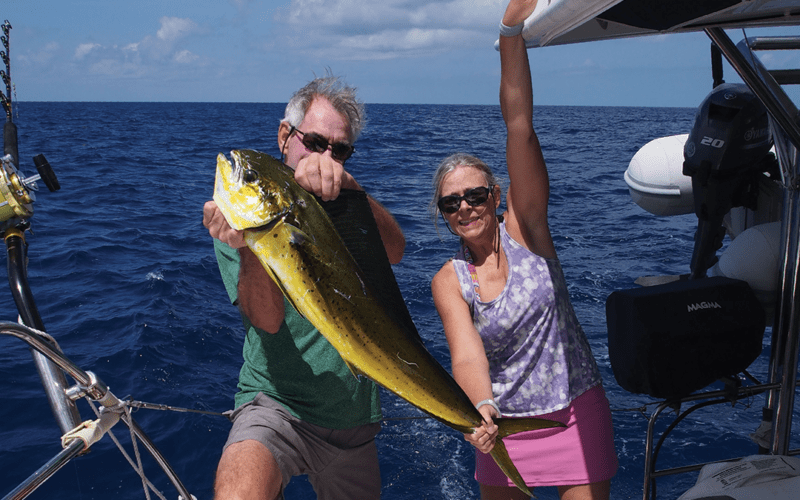
Stephen and Dawn Bell enjoy the cruising life aboard their Leopard 48 Catamaran Pilar, having cruised down the East Coast and into the Windward Islands of the Caribbean. The Bells emphasize the critical importance of always putting safety first while planning and undertaking ocean voyages. They prioritize safety not only in their manner of coastal and offshore sailing, but also in the emergency gear they select for use in a crisis.
Both Stephen and Dawn have received some formal medical training, so when someone gets hurt, they can dress wounds, splint broken bones, administer appropriate medications and make contact with emergency services for further treatment if needed. Moreover, they frequently recite and discuss emergency procedures to ensure both of them know precisely what to do in the event of an emergency involving the vessel, crew or both.
Also, important aboard Pilar is an extensive array of electronic navigation and communication systems, including AIS, radar and access to numerous sources of weather data, including regular reports from the National Hurricane Center, which are critically important for all vessels cruising in the Caribbean Basin.
OV:
How do you approach the subject of safety? Has your experience sailing offshore affected your thinking on safety?
D&PB:
“Safety is number one aboard Pilar.” That’s our motto and the terms we use for all guests who come aboard Pilar. Dawn and I have had lengthy discussions about safety and particularly the consequences of accidents that can be prevented with a focus on safety. The odds of finding fast and quality care onboard for an accident is slim, whether you’re offshore or at anchor in a remote harbor. Our focus is to change how you react to situations on board. Think before you move. Have proper safety gear and plan your moves before you attempt a trip to the foredeck or the bridge deck on our catamaran. Where are you going to tether yourself? What handholds and foot holds are you going to use? What equipment and tools are you going to take? What are you going to do when you get there, and how does your crew support you while you’re on the foredeck?
We review this with one another before we go out of the helm area. If there is an incident with the boat, rigging, sails, etc., we can usually get the boat in semi-stable condition before making the trip outside of the helm station. Then we have time to discuss the plan and safety before we go forward. Outside of a man overboard (MOB) situation, we talk about the consequences of an accident. Broken bones, head trauma, severe lacerations and the like are very big areas of concern for us. We are careful with each step, each handhold, and we think about them before we move. Too often sailors immediately react to a situation without conscious thought or planning. This is what helps prevent serious injury: stay calm, plan and act with one another.
We purchased a trauma-type medical kit for our boat. Before we made the purchase, we had a friend who was a helicopter ER nurse review the contents. The nurse agreed this kit had everything we should expect for an emergency. We added some items to the kit also on the advice of outside sources from the medical industry. We also have an oxygen bottle, but those can be problematic for checking into other countries, and they are difficult to have filled. We have two other medical kits we use for daily bandages and another for shoreside hikes. There are plenty of emergency medical kits available and they are worth the extra cost for peace of mind.
OV:
What planning do you do for a medical emergency? Did you receive any medical training before you began voyaging?
D&PB:
Both of us have had medical emergency training in the past. Stephen is a USCG Merchant Marine, an Army veteran and a certified “rescue diver” and had good training for medical emergencies. A basic medical emergency course, including lacerations, broken bones, head trauma, resuscitation, etc. is a must for all cruisers. Our medical kit also includes emergency “playbooks” that step us through emergency situations. These guides tell us what to look for, what to do and how to use the equipment in the emergency kit. We also subscribe to DAN insurance. DAN was originally designed for traveling divers, but is also available for cruisers. DAN will help cover cost of evacuations and transportation for serious emergencies at a very attractive cost.

OV:
What type of life raft do you have? What do you have in your abandon ship bag?
D&PB:
Pilar has a Viking six-person life raft. The raft is repacked every three years by a certified Air/Sea Safety and Rescue organization. We mount the life raft in an open, easily accessible area for quick deployment. The raft also has an emergency automatic deployment feature where if the raft goes underwater, the pressure releases the raft automatically. More information on the emergency automatic deployment can be discussed with your local air/sea safety organizations. We also have a ditch bag prepared for long passages and keep it on deck for quick retrieval. The ditch bag has packaged water, MREs (meals ready to eat), canned food, fishing equipment, prescriptions, safety equipment and sunscreen to name a few items. Don’t forget the can opener.
OV:
Do you have an EPIRB, PLB or tracking/messaging device like an InReach or SPOT?
D&PB:
We use all the above. We have an EPIRB, which is regularly tested and recently had a battery replaced. Be sure you have these registered with NOAA in their beacon registration application. We use a Garmin In-Reach tracking device, and we keep tracking on anytime we sail. We connect that to our own website so anyone can access the website and see our position updated every half hour. We also have personal locator beacons (PLBs) on our life jackets. In the event of a MOB, the PLB can be activated and will show up on our navigation system for rescue and retrieval purposes. We have Starlink, which connects the Garmin InReach to our website and gives us stable internet connectivity for everything from weather reports to text, email and websites.
OV:
Do you actively use radar for collision avoidance?
D&PB:
We have radar and recently upgraded to the Raymarine Quantum series. Radar technology has changed dramatically, and the new units are a must to have on board. We use radar the most when we are in high traffic areas and weather situations like squalls and fog. On long passages, we may turn it off to save battery power, but it is still available should we feel the need to compare it with AIS sightings or weather concerns. The new radar allows us to establish targets so we can see the direction of other vessels and better judge possible collision courses that may require course changes. The radar does well to identify storms and squalls that we may need to avoid, allowing us to initiate sail reefing before we hit the fronts of the squalls.
OV:
Do you have an AIS unit?
D&PB:
We have AIS, and it is on anytime the instruments are turned on. In our opinion, AIS is one of the top navigational devices to have onboard. The information available from AIS is amazing for navigational decision-making. AIS identifies other vessels, buoys, towers and shore-side navigational aids that are AIS-equipped. AIS tells us the size of other vessels, the course over ground (COG), speed over ground (SOG) and closest point of approach (CPA). This allows us to make course changes well in advance to avoid possible collisions. AIS identifies the vessel name, so if you need to contact them, you know who to call, and they know who you are as well. AIS is a top-of-the-list navigational aid for cruisers.
OV:
What type of weather data do you use on your voyage? How do you gather weather information?
D&PB:
We use multiple sources for weather data. For daily routing, we refer to PredictWind, Windy and Sail Flow. They all use the same available data and report it using their own algorithms on their apps. These services are very accurate for daily weather decisions and give the best data available out to 10 days. We get twice-weekly tropical forecast reports from the National Hurricane Center in an automated email. And, of course, the NOAA weather reporting via online websites and VHF are applicable as well. We often compare these applications when making sail plans.

OV:
Do you use a weather-routing service?
D&PB:
We have an annual subscription to Chris Parker’s weather forecasting and routing service. We get (the) daily weather forecast for the area we are sailing in and can change that as we wish on Chris’ website. The weather service also offers weather routing for long passages we plan to make. The annual subscription offers a set of these passage routing services, and we can purchase more as we go if necessary. When making passage decisions, we compare all our weather apps, Chris Parker’s information and our boat’s best points of sail before departure.
OV:
Do you have a storm trysail? A drag device like a drogue or sea anchor?
D&PB:
Although we have not done so yet, we plan to put a Gale Sail on board our catamaran. Most catamaran sailors will say strategy for 50-knot winds is a small head sail, no mainsail and steer down-sea with a plan too slow the boat. The Gale Sail is a slip-on head sail which wraps around the existing genoa and is hoisted on the spinnaker halyard. One could reef down the existing genoa, but at least on our boat, it would have a less-than-desirable shape and the pressure on the stay and the furling line is concerning for us. It also runs the risk of the furling line slipping through clutch unless cleated off, and then we could break the furling line, especially if it is aged. The Gale Sail is expensive, but like all safety equipment you may never use, it will be worth more than dollars when you need it. We also have ample spare lines in our line locker that we can use for trailing warps that can slow the boat and help with steering. A trailing warp is a long line with multiple large knots attached to either side or both sides of the stern. Most catamarans find this solution works to slow the boat. Monohulls will usually use a third reef in the mainsail and a dramatically reefed headsail or a storm sail in storm wind conditions.
OV:
What are your future voyaging plans?
D&PB:
Pilar is presently in the Windward Islands of the Caribbean. We plan to head to Panama for a January 2025 canal transit and the Pacific via Galapagos and Marquesas. In the meantime, we’ll leave the Windwards in mid-March and head to the ABC Islands, then maybe Colombia and on to Panama. We’ll haul for paint and repairs for the hurricane season in Panama. November to January, we look forward to some time in San Blas while we prepare for the canal transit and the Pacific crossing. ν

